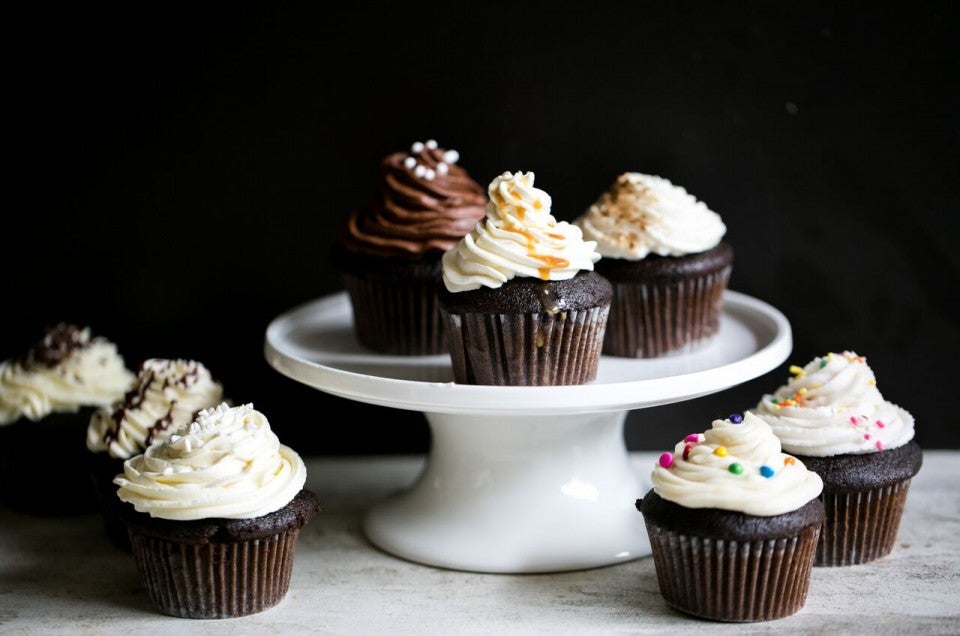


While humans may love to bask in hot weather, when it comes to cake it's a different story. For bakers, the prospect of putting a carefully decorated cake on a table for hours during summer's heat is literally dreadful. But the wedding, birthday party, or baby shower must go on. So what's the best cake frosting for hot weather? We decided it was time to put a range of frosting formulas to the test.
First, let's bring out the contenders. I made every kind of frosting I could think of. American Buttercream (fat, confectioners' sugar, vanilla, and a little bit of milk or cream); whipped chocolate ganache; stabilized whipped cream; Swiss, Italian, and German buttercreams; and Cream Cheese Frosting.
Even though the test kitchen can be a pretty warm place (especially when 8 or 10 ovens are cranking at the same time), to understand how different frostings hold up to heat I reach for the hair dryer.
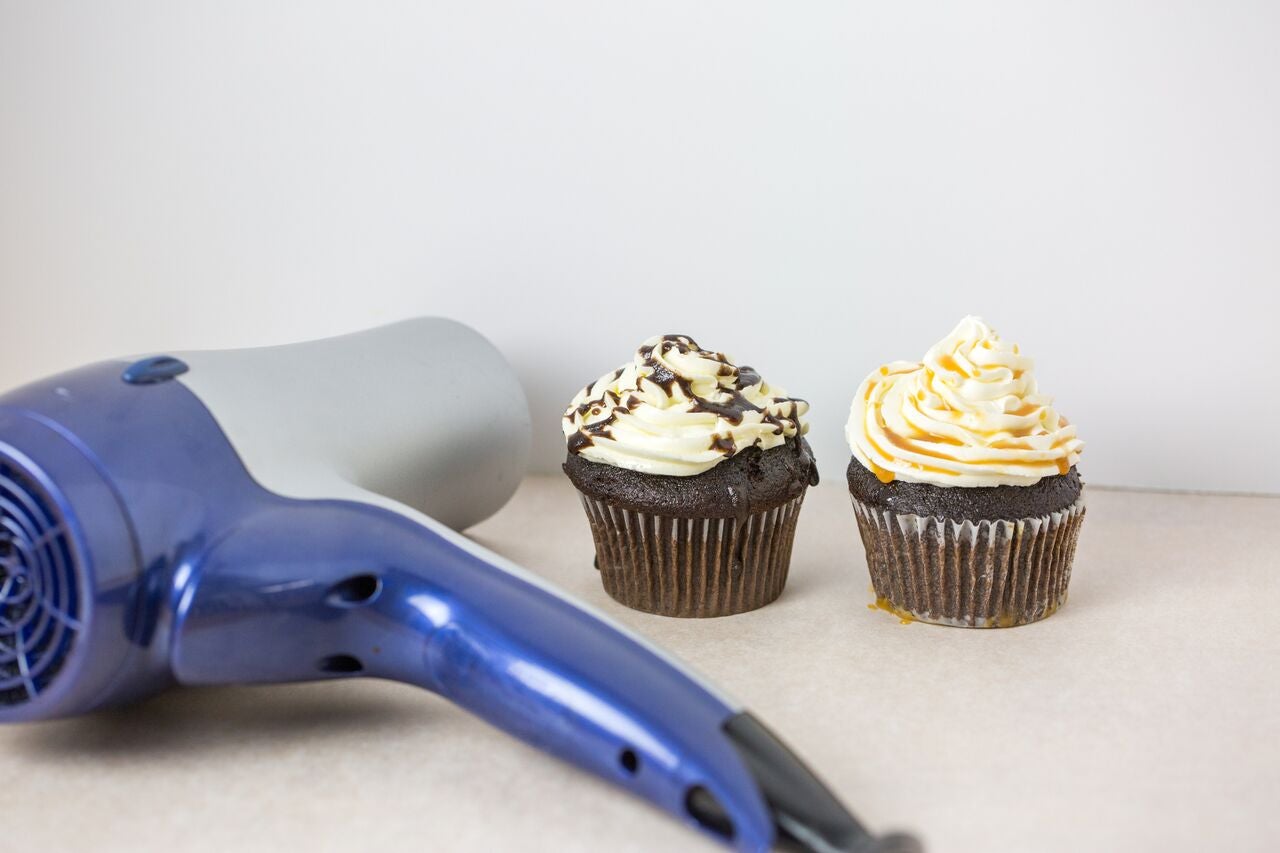 I put two cupcakes with two different frostings next to each other and let them have it with the hairdryer. Before I show you all of the results, a little bit of science.
I put two cupcakes with two different frostings next to each other and let them have it with the hairdryer. Before I show you all of the results, a little bit of science.
Frosting is made of sugar, fat, air, and flavoring. This magical composition is gloriously talented. It seals cakes to keep them moist. It can take on any shape a decorator can imagine. And it tastes really, really good.
Alas, the first two components we mentioned— sugar and fat — have particular weaknesses when it comes to the best cake frosting in hot weather.
Fat provides the structure in frosting. When whipped, fat captures air, making frosting light and spreadable.
All fats have different melting points. Butter, the most common frosting ingredient, melts at 90°F to 95°F. Margarine is just slightly more heat-resistant than butter (depending on its formula, anywhere from 90°F to over 100°F). Coconut oil liquefies at 76°F. Vegetable shortening stays solid all the way up to 115°F.
Sugar makes frosting sweet, obviously. In some frostings, its crystals help to create the air pockets that make frosting light and creamy. In others, it's added to meringue as a boiling syrup, which cooks the egg white proteins and gives the frosting its "backbone."
When the weather is hot and humid, sugar has the unfortunate habit of pulling water from the air. Cold frosting right out of the refrigerator will "sweat," with beads of condensation forming all over the surface, aggravated by the hygroscopic (water-attracting) nature of sugar.
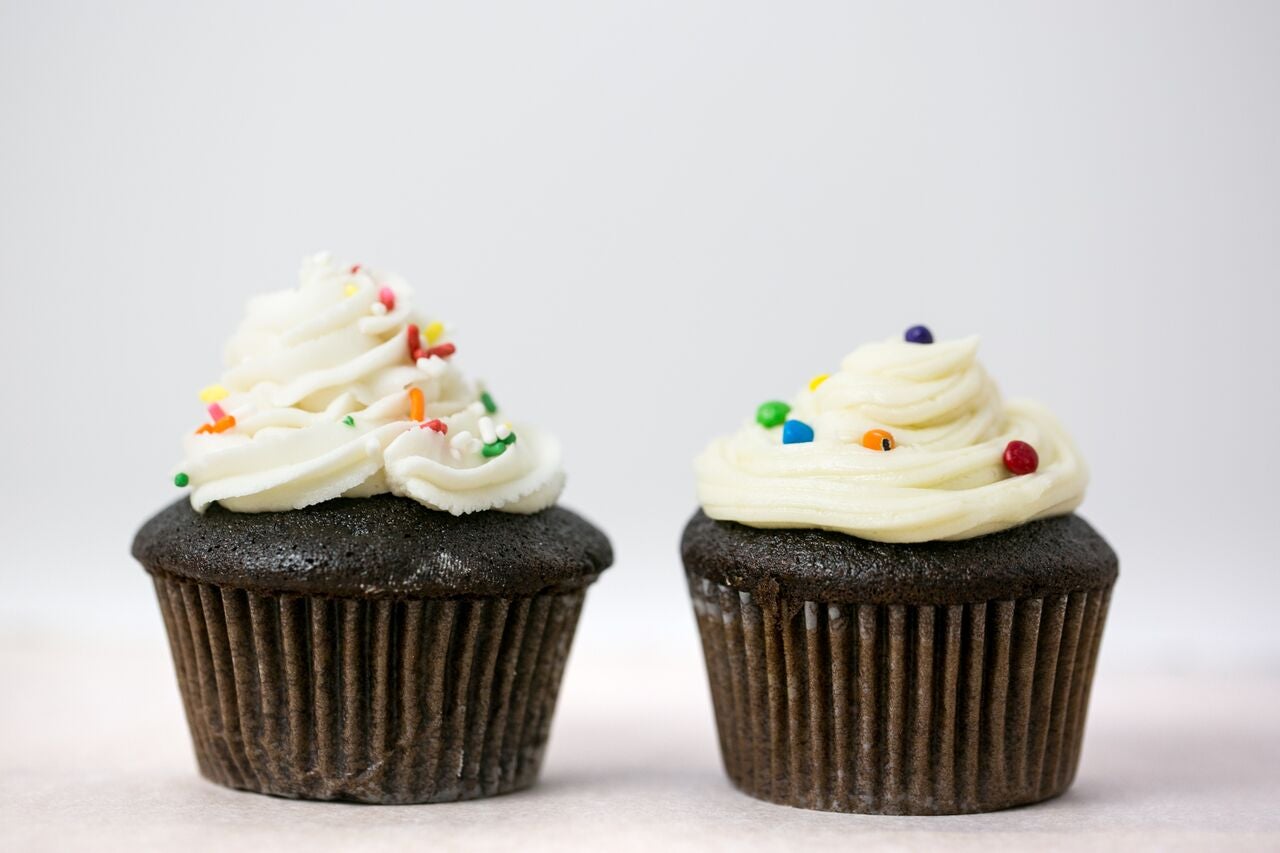
First up? American Buttercream. On the left, an all-shortening version, sometimes called decorator's frosting — mostly because it will hold a nice, sharp edge when piped. Definitely a case of looks over taste.
On the right, buttercream made with all butter. It was piped with the same tip, from room-temperature frosting. I could have had more definition if I'd chilled it a little before piping.
How do they hold up?

Behold a tale of two melting points.
As we mentioned earlier, shortening can take the heat. After 3 minutes at full blast, the all-shortening buttercream looks pretty much the same as when it landed on the cupcake. Alas, poor butter doesn't fare as well.
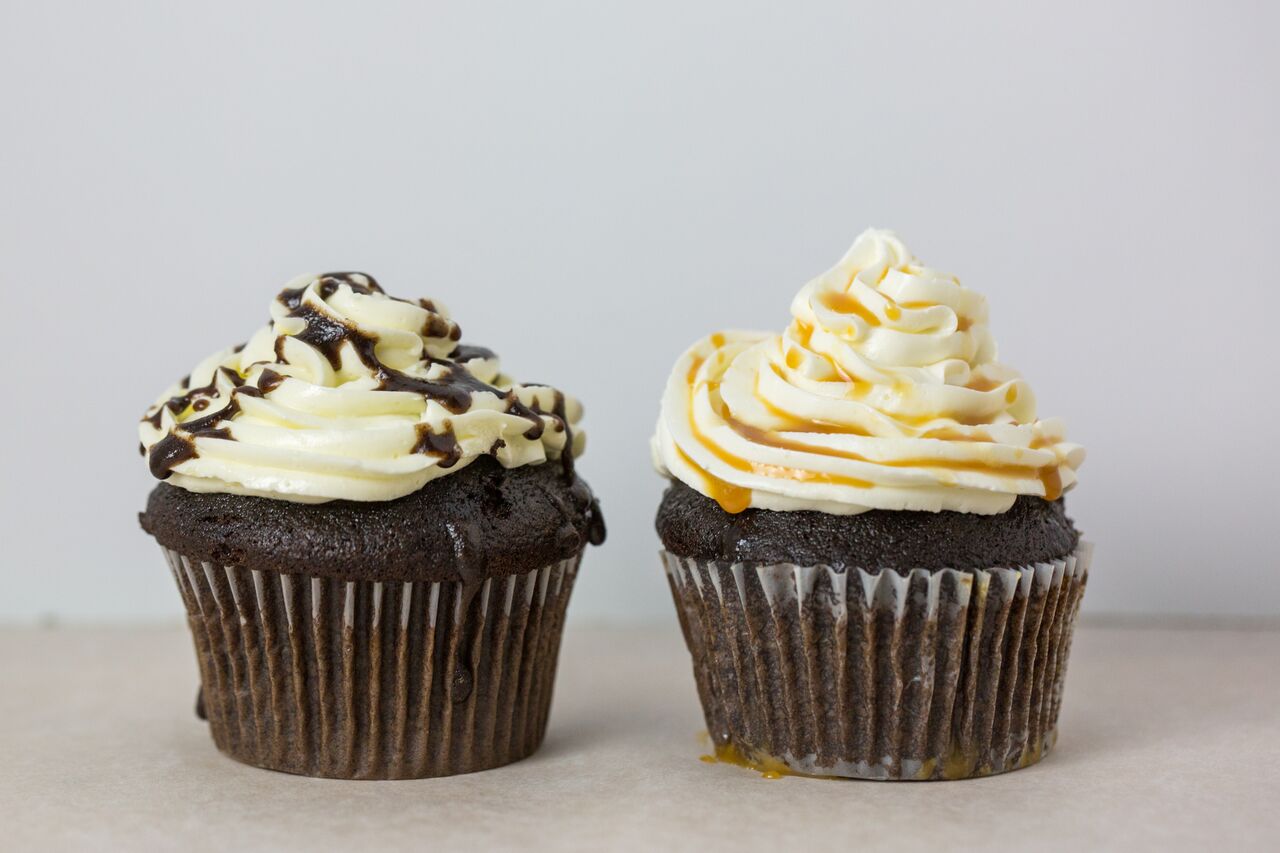
I have long relied on Italian Buttercream for special-occasion cakes. People often ask me how it compares to Swiss, and I tell them I think Italian is sturdier. Now I have a chance to see if I'm right.
The cupcake on the left is topped with Swiss Buttercream, and the one on the right with Italian.
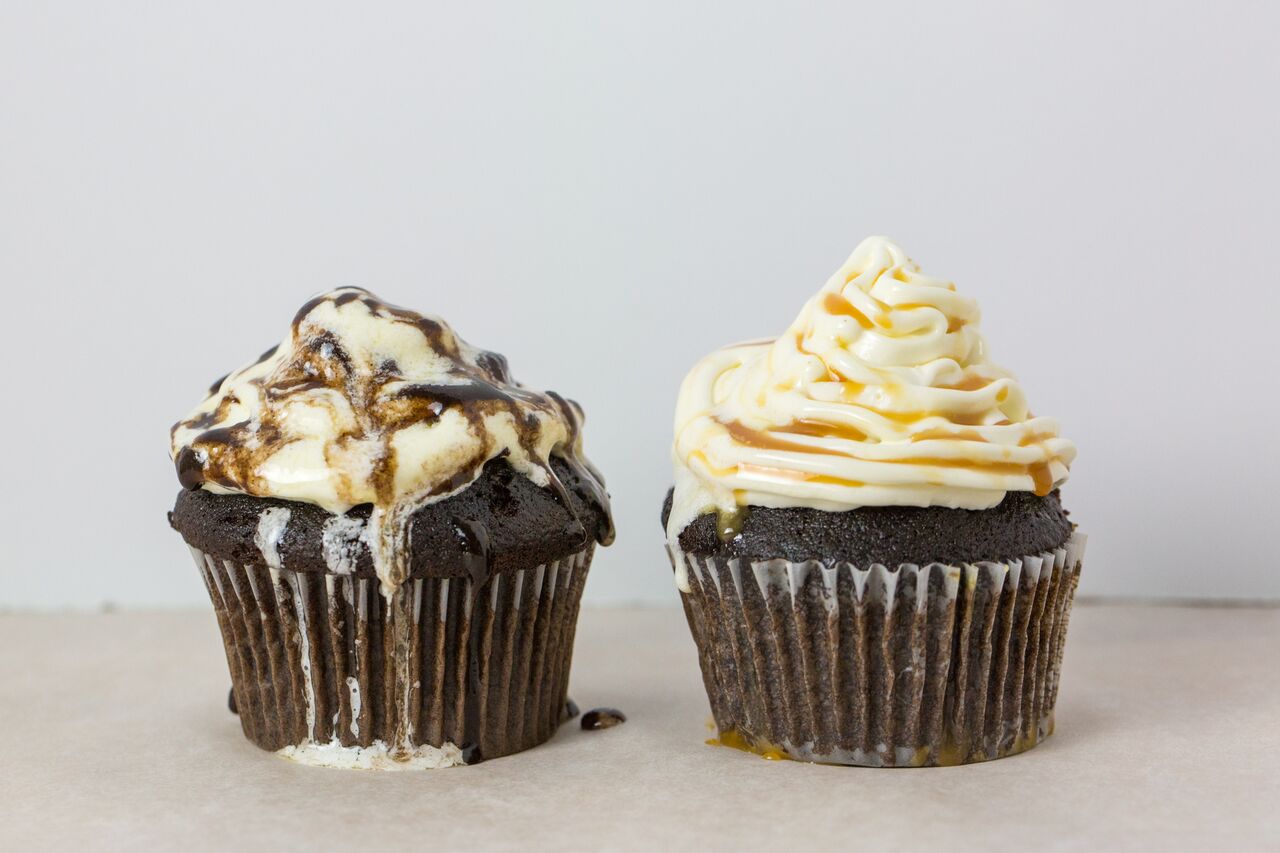
The full force of a hot hairdryer doesn't do either frosting any favors, but the Italian holds up better than its counterpart. The meringue in Italian Buttercream is cooked to a higher temperature, which gives the frosting a sturdier structure.
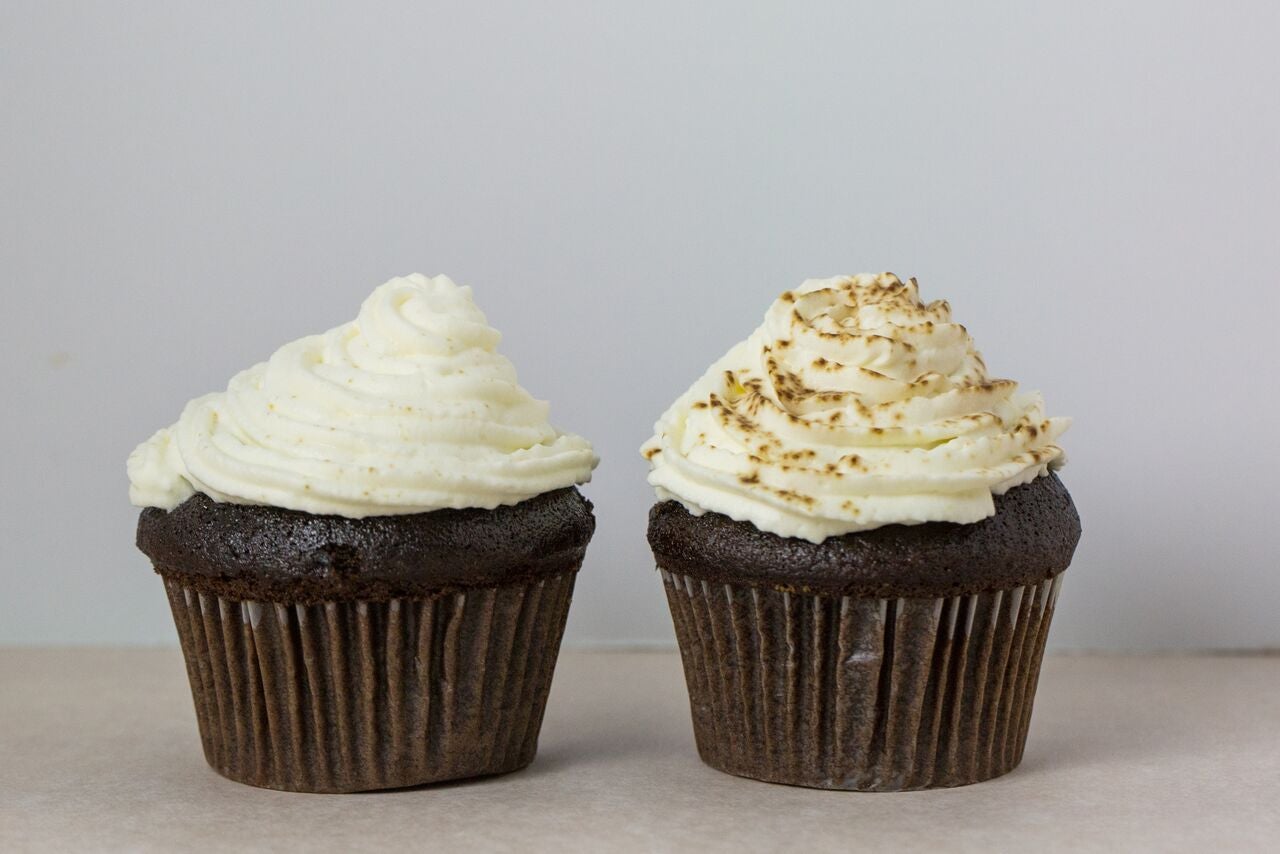
There are two ways to stabilize whipped cream. On the left, unflavored gelatin is added (dissolved in water, heated to melt, cooled to lukewarm, added to cream that's three-fourths whipped).
On the right, a mixture of sugar and Instant ClearJel (two parts sugar to one part ClearJel) is sprinkled into whipped cream that's five or six turns shy of being finished.
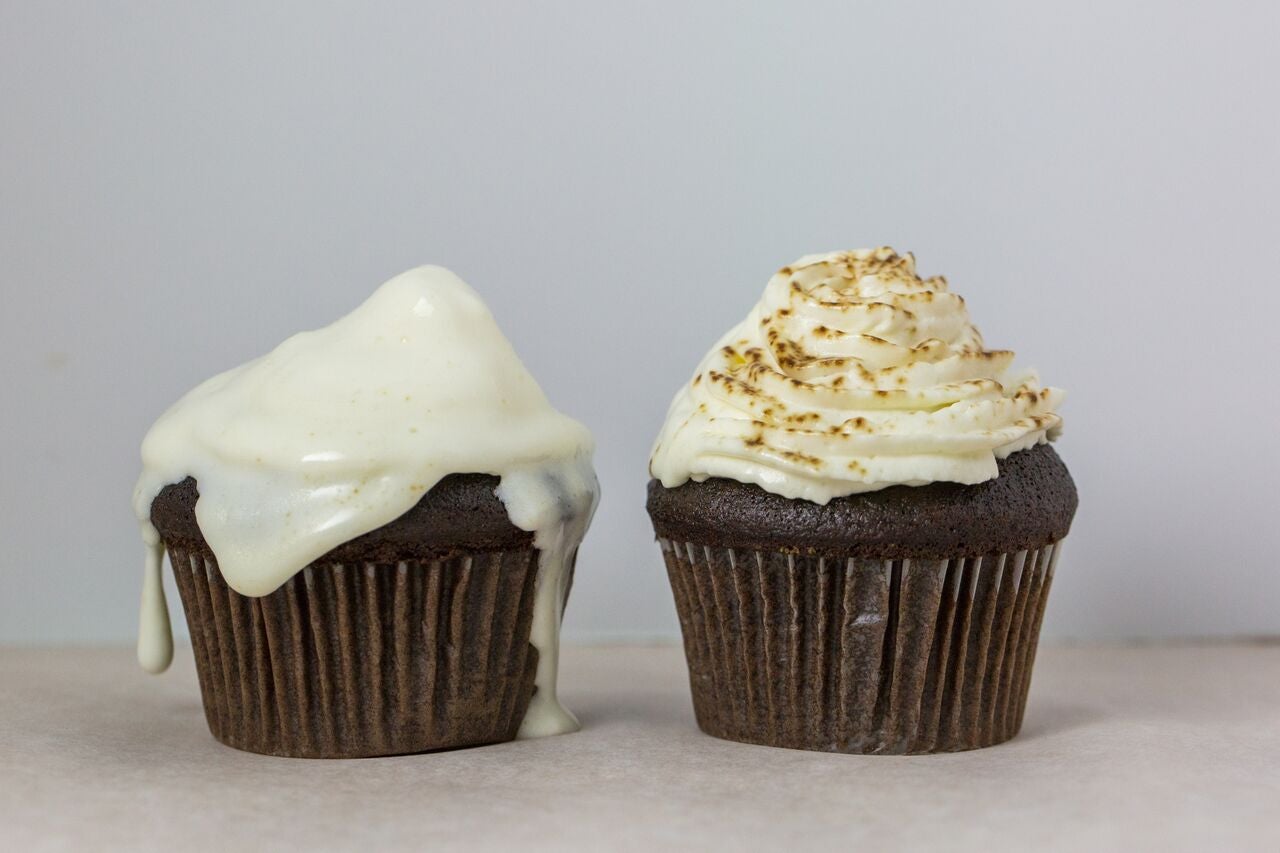
Not surprisingly, neither version is at its best under the blast of warm air; but the Instant ClearJel version holds up significantly better. Because the starch in the ClearJel is heat stable, it holds its shape, where the gelatin just... melts.
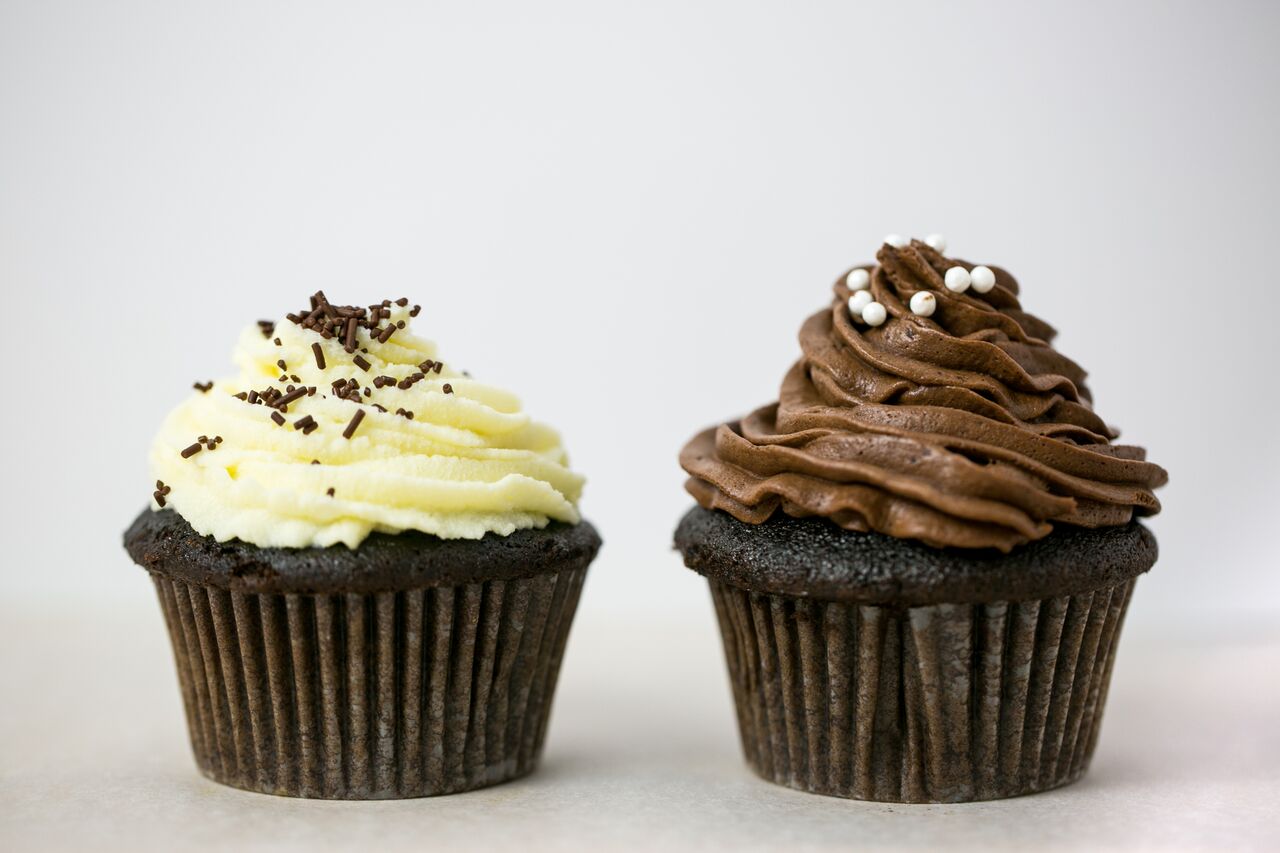
Chocolate is frequently the answer to any problem, so it's only right that we try some here. These ganaches are equal amounts of chocolate and cream by weight, melted together until smooth. After chilling, they're whipped until thick enough to pipe. That's white chocolate on the left, semisweet chocolate on the right.
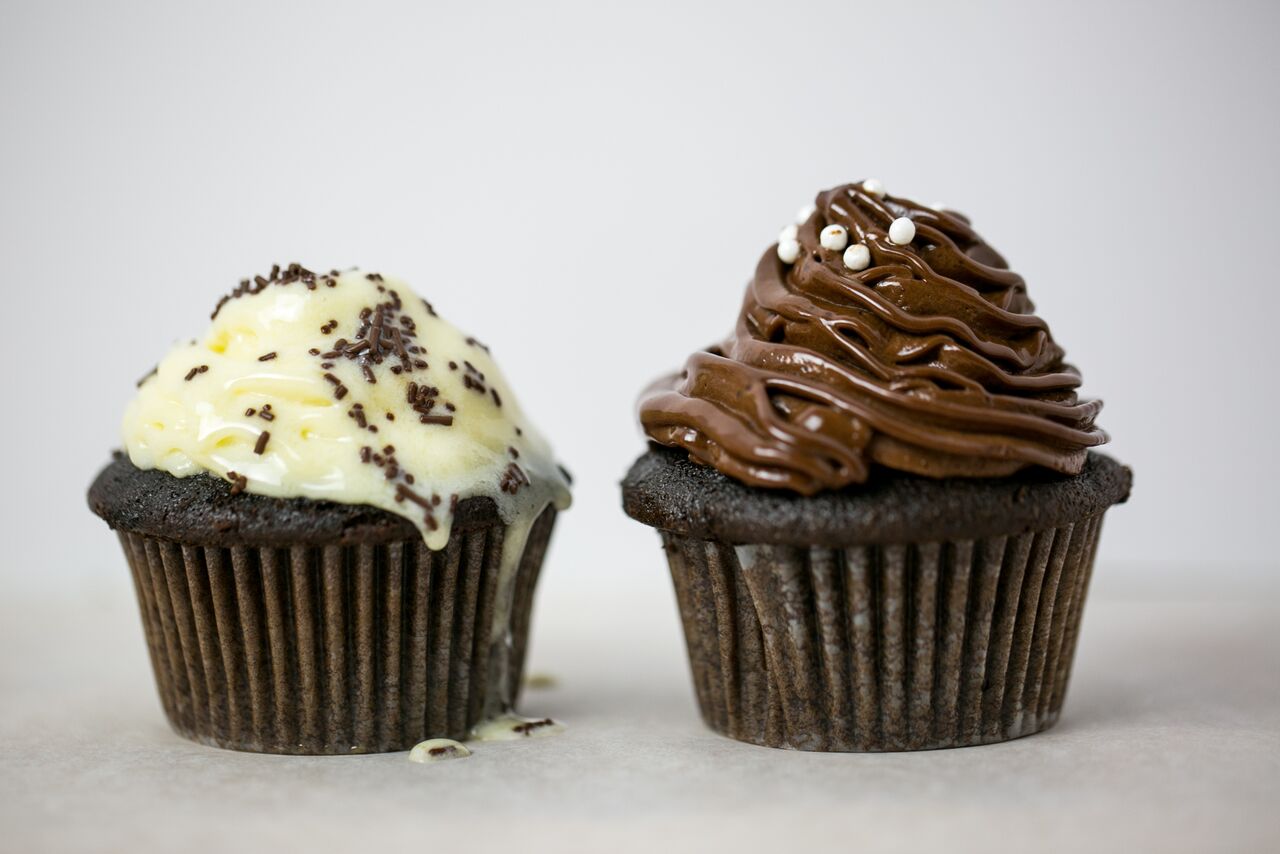
White chocolate is sweetened cocoa butter flavored with vanilla, and sometimes with added milk solids. The cocoa butter is no match for the heat. Semisweet chocolate has more cacao solids in it, therefore it has more structure and staying power.

German Buttercream (on the left) isn't as well known as some of its other frosting cousins. It starts with a rich egg and cornstarch pudding that's cooled and whipped with butter. Because of the cooked pudding base, I thought it might have magical heat-resistant characteristics.
Next to it, I put a cream-cheese frosted cupcake, thinking it doesn't stand a chance.
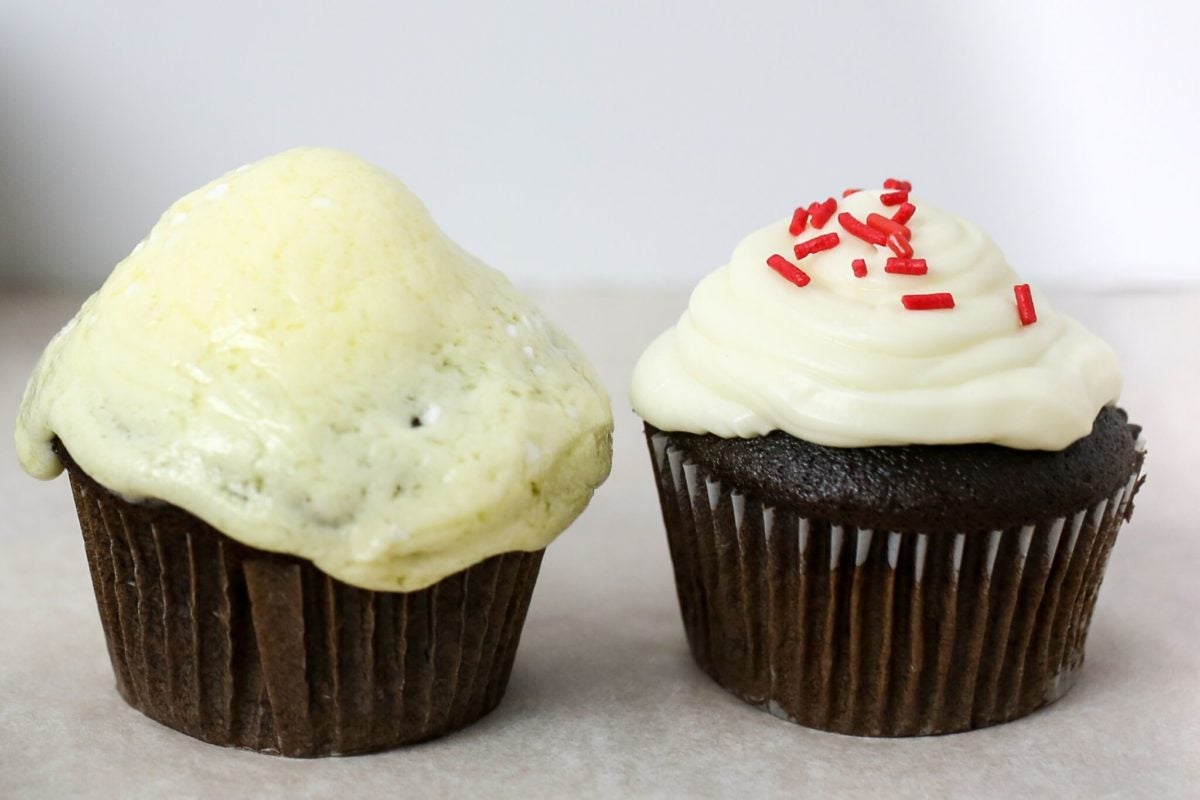
The results are quite surprising. The German Buttercream holds out longer than the Swiss or Italian; but after 3 minutes of high heat it starts to slump and ooze.
The shocker is the Cream Cheese Frosting. It. Does. Not. Care. I put the hair dryer an inch away from it and hold it there for a loooooooong time. No change. Supreme indifference. Astonishing resistance to melting. I conclude that the protein in the cream cheese only firms up under the heat.
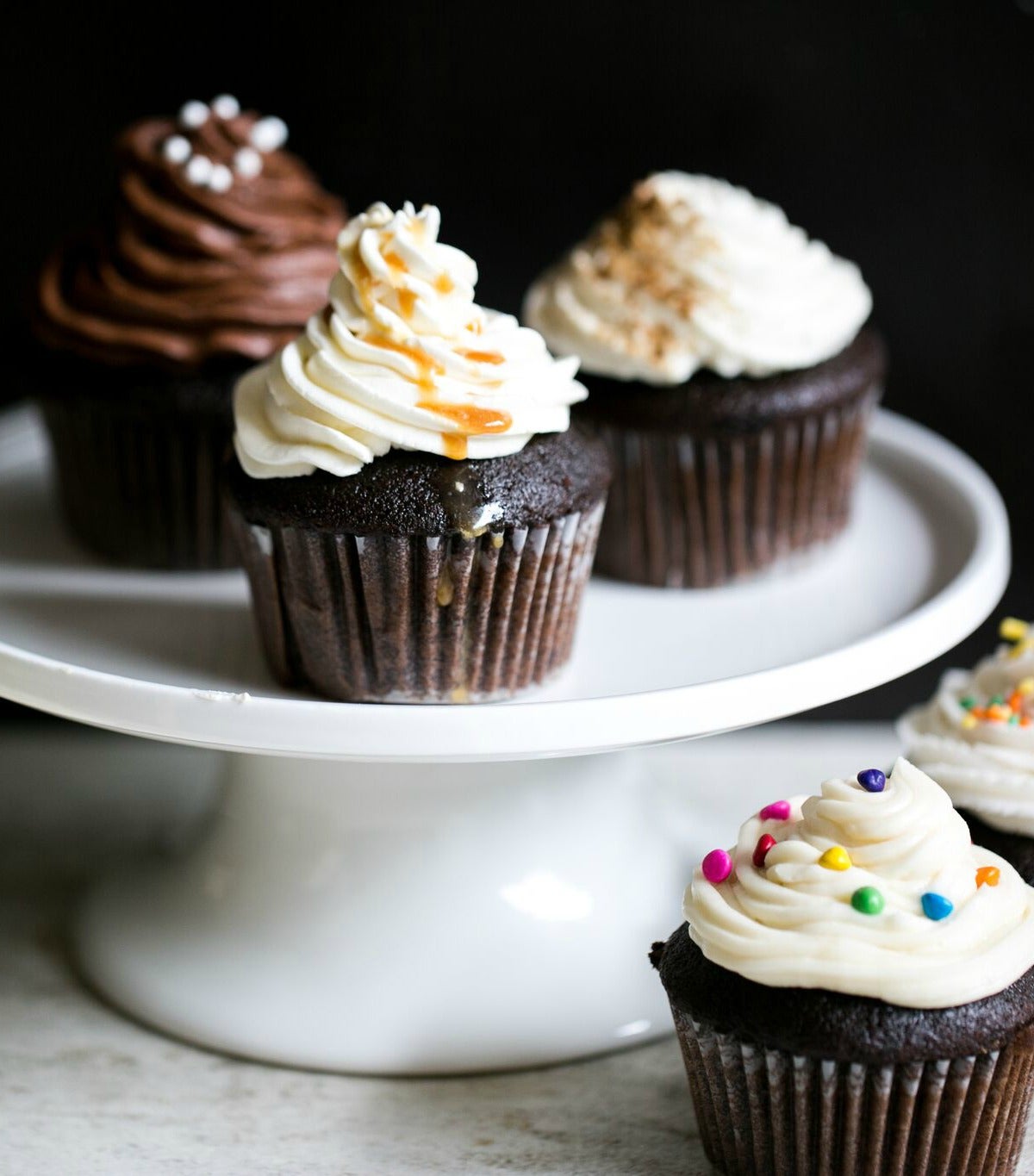
What's the best cake frosting for hot weather?
I still believe in the all-around greatness of Italian Buttercream. For summer wedding cakes, I'll add some shortening to it (about half a cup) as a hot-weather insurance policy.
For a less formal cake with simpler decoration, I'll be using German Buttercream more often.
And if I need a cake that can really take the heat, Cream Cheese Frosting is coming to the party.
Do you have any hot weather cake stories to tell? We'd love to hear about them in the comments below.
Our thanks to Anne Mientka for the photos in this post (and the giggles that went with them).


August 17, 2024 at 6:55am
Thank you so much for this post, it’s so detailed and perfectly explained, just what I needed for a summer birthday party in the park. I’ll be trying the cream cheese frosting!
August 17, 2024 at 9:44am
In reply to Thank you so much for this… by Danisa (not verified)
You are very welcome, Danisa! Happy Baking
August 6, 2024 at 9:04pm
Hi there. Great blog with do much helpful information.
I am in the process of making a wedding cake (getting cakes baked so I can freeze them) for a wedding being held on August 17th in Maine. We have been haveing extremely hot and humid weather this summer. My cake will have 4 double layer tiers. I have support for each tier of the cake but would you recommend having supports in-between each layer as well?
Also I really want to use an American Butter cream , as I suffer from lost of chronic pain so this is the easiest and quickest frosting to make or I think any way lol. Do you think this will do alright here in Maine on a hot day? I was told that doing abuttercream using all shortening doesn't taste nearly as good as one made from all butter but the shortening one would hold up better I think. Can I do half and half so I get the stability of the shortening but get the butter taste?? Any thoughts tips and tricks you wanna Send my way that would be so helpful. Thank you so much!!
August 7, 2024 at 4:15pm
In reply to Hi there. Great blog with do… by Loretta Livingstone (not verified)
Hi Loretta, because this is a 4 tier special occasion cake, I would also recommend placing dowels in each tier to support the layers as well. Happy Baking!
August 5, 2024 at 1:00pm
i read this in good time!! i'm making 2 large carrot sheet cakes with cream cheese icing for a bake sale this weekend, and its outdoors, with some shade. Glad to hear cream cheese holds up the best. Now here's another question for you; would the cream cheese icing also contain butter or just cream cheese to hold up? im wondering if the butter would make things sloppy. Opinions?
August 5, 2024 at 4:43pm
In reply to i read this in good time!! i… by Char (not verified)
Hi Char, the cream cheese frosting recipe that was used in this blog post seems to hold up great, and it has butter in it, so you should be fine!
July 1, 2024 at 10:03am
Hi there - I'm making a 3-tier (8, 10, 12) wedding cake that will be displayed outdoors in about 2 weeks from now (July 13, 2024) and I'm in the Pacific NW - expected 80 degree temp that day. I used the NYT wedding cake recipe as my guide (https://cooking.nytimes.com/recipes/1024238-toasted-sesame-and-citrus-w…) but I have tweaked the flavors to include a pistachio crunch, apricot jam, and fiora di sicilia swiss meringue buttercream. Cakes are now baked/assembled and in the freezer. My couple of big questions are: 1) Do I need additional supports for stacking beyond the cardboard cake rounds? 2) How long do you think is safe to have the cake set up outdoors before things go awry with the swiss meringue buttercream? I'm starting to have cake stress.
July 6, 2024 at 9:26am
In reply to Hi there - I'm making a 3… by Melanie (not verified)
Hi Melanie! When it comes to stacking wedding cakes, we would recommend having some extra support in addition to the cake rounds. Food safe wooden or plastic dowels inserted under each layer would be something to consider so that your creation stands tall for the entire event. As for timing, if you are transporting and setting up the cakes from a frozen state, you will have a bit more time to display that cake before the heat sets in. Generally, we like to have wedding cakes displayed for no more than 2 or 3 hours (for food safety reasons). As it sits, the frosting will naturally soften so try to set it up as close to the reception starting time as possible. Happy Baking!
May 11, 2024 at 12:21pm
Is there a specific clear gelatin unflavored you would use to stabilize cream cheese buttercream frosting & how much gelatin to per batch which has 1lb confectioners sugar?
May 11, 2024 at 4:07pm
In reply to Is there a specific clear… by Ann (not verified)
Hi Ann! When it comes to stabilizing frostings, Knox Gelatin will be just fine to use. It is a clear, unflavored gelatin that can be found in many stores. As for how much to use, it really depends on a few more factors besides the amount of sugar. You'll have to take into consideration the amount of butter, cream cheese and any other liquids such as heavy cream. While we don't currently have a cream cheese frosting recipe that is stabilized with gelatin, other recipes recommend using 1 teaspoon of gelatin bloomed in 4 teaspoons of water for a traditional sized batch of frosting (yielding 3 to 4 cups).
Pagination